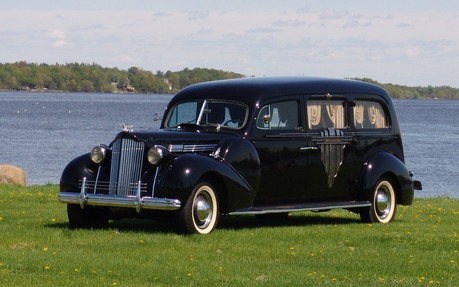1939 Packard : One final car ride
Halloween is by far the creepiest day of the year, with lost souls coming back to earth – perhaps some are nostalgic for their final car ride in an elaborately decked-out 1939 Packard!
The bodies of the dead have a long history of being transported by their survivors. Horses were long considered unworthy for such a task, and it wasn’t until the 18th Century that corpses were carried by funerary vehicles. By the 19th Century, there was a vibrant industry in funeral carriage decoration, inspiring respect for the deceased.
A dead good pioneer
Motorized hearses were introduced in France at the turn of 20th Century, but it was not until the 1920s that they became widely accepted in North America. The first person to have the honour of traveling to his final resting place by motorized hearse was Wilfrid A. Pruyn of Chicago. And although it seems that the experience left him rather cold, it marked an important shift for the hearse industry.
During the first half of the 20th Century, brands such as Packard built chassis, which they then sold to companies specializing in funerary vehicles. Packard chassis included the mechanical organs and often the front section of the auto body, including the dashboard and front doors. The rest was left to the manufacturer to complete. The 1939 Packard Model 120 featured here was built by Brantford, Ontario, firm Brantford Coach Ltd., now Trailmobile Canada. At the time, Brantford was associated with Cockshutt Plow Co., well-known in agricultural circles, and Henney, an American hearse builder.
Prior to the 1980s, you could get a coffin in (or out, as the case may be) by way of the side doors or the rear. Henney patented a clever casket loading mechanism called the Nu-3-Way, allowing you to pivot the casket bed (the base on which the casket is placed before sliding it into the vehicle) in three different directions. Other features of this hearse included velvet curtains on the windows, numerous wood appliques on the sides and rear door, as well as in the interior, and crucifixes on the rear side windows.
This hearse was purchased by Hawkesbury’s Berthiaume Funeral Parlours in 1981. Founded in 1896, the company is now run by two Berthiaume brothers. They fondly recalled the 1937 Packard hearse their father had once owned, and therefore jumped at the chance to acquire the similar 1939 Packard. They also own a funeral carriage that dates back to 1896. These two funerary vehicles can still be used in the summer months – sometimes for up to 20 trips. Although the Packard still works like new, it is always accompanied by another hearse, just in case!
A look back on history
Packard first got into the business in 1899, following a funny series of events. James Packard owned a problem-prone 1898 Winton and eventually filed a complaint about the vehicle’s frequent stalls to Alexander Winton, the manufacturer responsible for the stubborn vehicle. When Winton brushed off his complaints, the disgruntled Packard decided to show the rude automaker just who he was dealing with – and he decided to create his own brand!
The first Packard models were a hit, and demand increased steadily over the following decades. Before WWI, Packard even built trucks, and from the 1920s through to the 1940s, Packard models were in the same luxury category as vehicles built by Cadillac, Pierce-Arrow and Peerless. Stylish and prestigious, these vehicles represented nobility. Thus, when motorized hearses became popular, it simply made sense to call on Packard. It’s also worth noting that, at the time, cars built by other brands, such as Cadillac, Buick, LaSalle, Pierce-Arrow and Lincoln, were also converted into hearses.
Generally speaking, hearses have an easy life, as they don’t tend to clock many kilometres. Thus, they can last for several decades. Funeral parlours, however, often update their fleets long before the vehicles have expired. Which begs the question: where are all the retired hearses? The simple answer is that once a hearse is no longer employed by a funeral business, it usually gets sold to companies that ship them to developing countries – or to private owners with a dark sense of humor. The Berthiaume brothers have always refused to sell them privately.
Today’s hearses are built as though they were limousines, quite a departure from the hearses of the 1930s. You take a Cadillac or Lincoln, cut its chassis, extend it, and add ceremonial regalia. A modern hearse can easily cost $80,000. Meanwhile, this 1939 Packard was assessed at $58,000 ten years ago. Anyone wishing to get a better look at it need not head to Hawkesbury. Just rent the Quebec film "Alys Robi, ma vie en cinémascope." This 1939 Packard plays a role in it!
